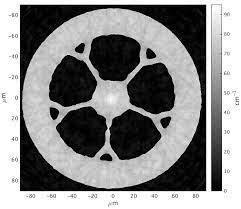Computed Tomography (CT) is a common imaging modality used in industrial, healthcare, and security settings. It is widely used at Lawrence Livermore National Laboratory (LLNL) for non-destructive evaluation using all manner of waves and particles (e.g., x-rays, neutrons, protons). During a common CT scan, a beam of x-rays is passed through an object (whether a person, airport luggage or industrial part), recorded from many angles on a detector, then processed by a computer to generate 2D cross-sectional images or tomographic slices of the object. A number of these tomographic image slices are then digitally stacked together to form a full 3D volume of the object’s interior.
Many types of CT reconstruction and analysis software methods have been implemented since its invention in the early 1960’s. However, most are specific to a single scanner setup, require hardware-based knowledge, and are susceptible to a number of artifact-causing problems such as scatter, metal shadowing, detector blur, and beam hardening. Frequently, the specialized algorithms needed to correct these issues take much more time to process and/or may not significantly improve the image. The resulting images typically contain qualitative pixel values with little physical meaning, not quantitative 3D features such as density or atomic number. Consequently, this type of CT scanning is not as helpful for applications that require physics-based measurements or high throughput (i.e., industrial non-destructive evaluation or cargo screening) or low doses (medical). These deficiencies limit industry adoption. CT performance improvement is essential as the need increases for more challenging 3D imaging problems with different materials in various sizes.
To solve these challenges using new and existing CT system designs, LLNL has developed an innovative software package for CT data processing and reconstruction. Livermore Tomography Tools (LTT) is a modern integrated software package that includes all aspects of CT modeling, simulation, reconstruction, and analysis algorithms based on the latest research in the field. LTT contains the most expansive and recently published CT data preprocessing and reconstruction algorithms available.
LTT is platform-independent (Windows, Linux, and Mac) and capable of processing data on one or more graphical processing units (GPUs) or other hardware accelerators, including high-performance supercomputers. It can be used as a stand-alone application, accessed as a library from existing applications such as MATLAB or Python, or integrated into a separate graphical user interface (GUI) that the user may require.
The algorithms in LTT are capable of processing CT data from raw detector counts to reconstructed volumes and are designed to provide quantitatively accurate results (with specified units) in a timely manner. Most conventional scanner geometries (parallel-, fan-, and axial/helical cone-beam) are supported, as well as modern fixed gantry systems in which the user provides the location of every x-ray source and detector pair and the detector orientation in a text file.
With x-ray and neutron cross-section tables included, LTT is the right tool to research the best CT scanner and experimental designs based on physics models. It incorporates algorithms to correct for beam hardening, scatter, blur, and other common issues of CT data acquisition. LTT implements advanced iterative reconstruction algorithms to build 3D volumes of an object in cases where the data are incomplete, such as limited view, sparse view, high aspect-ratio objects, or metal obscuration. This versatility greatly enhances LTT’s usability and provides a means to simultaneously process, reconstruct, and analyze CT data and volumes.
LLNL has published demonstration videos of LTT:
LTT’s primary benefits are:
- Reduced Processing Time: Automatically optimizes for the full capabilities of many computer system architectures including multiple nodes and multiple GPUs (NVIDIA, AMD, or Intel)
- Accuracy: Provides quantitatively accurate results independent of the CT scanning system
- Flexibility: Processes data from any CT geometry and runs on Windows, Mac, and Linux platforms
LTT is a highly efficient and versatile research tool for CT. By reducing the time needed to properly reconstruct a 3D image of a scanned item, LTT can increase throughput and reduce image processing labor costs for applications such as industrial quality control scanning and airport baggage screening. LTT provides quantitatively accurate results independent of the system, and its flexibility allows data to be processed from any CT geometry, independent of the computing platform, making it suitable for many industrial applications.
If approved and used for medical diagnostics applications, LTT has the potential to significantly reduce the number of projections required—which reduces both the scan time and the patients’ exposure to radiation. And by reducing the time needed to properly reconstruct a 3D volume, LTT could increase throughput for CT medical screening—which further reduces the operational costs and time demands on healthcare providers.
LLNL has filed for patent protection and has copyrights on the LTT software. LTT is at a technical readiness level (TRL) between 7-9 depending on the applications of interest.
To build the community of LTT users and receive feedback to improve future versions, LTT is being provided for academic and research purposes. For companies that are considering commercialization and want to evaluate the software, one-year demonstrations licenses are available. Interested parties please visit softwarelicensing.llnl.gov
LLNL may offer other licenses or partnership agreements on a case-by-case basis. Send an email to softwarelicensing@llnl.gov and describe your business needs and determine what rights and agreements may be available for you. For example, LLNL is interested in partnering with distributors and system integrators to commercialize Livermore Tomography Tools (LTT) with existing CT scanning systems and products. LLNL is also interested in collaborating with qualified research partners.
A U.S. Government Use Agreement can be requested by Federal Agencies and their authorized contractors by emailing softwarelicensing@llnl.gov.


